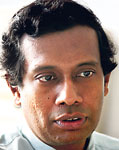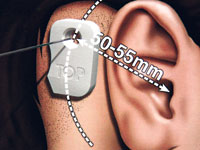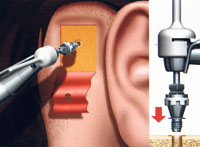Five-year-old Kavishka Dilshan, with his head in plaster, is walking around Ward 12 of the Lady Ridgeway Hospital for Children, oblivious of the fact that he is a tiny trailblazer in Sri Lanka.
For Kavishka is the first to undergo a revolutionary operation to instal a bone-anchored hearing aid (Baha) in Sri Lanka. The operation is done in two stages for children and for Kavishka it will be completed in 6 to 9 months.
"It was a first both in the state and private sectors," says Consultant ENT Surgeon Dr. A.D.K.S.N. Yasawardene, explaining that Kavishka's 90-minute operation was done on the morning of March 28.
Explaining this new technology, he says that the skull bone is opened up and a special screw is fixed to the skull bone just behind the ear, on to which is attached a very small hearing aid, dubbed a flip-on or snap-on aid.
 |
| Dr. Yasawardene |
Earlier, MediScene understands, that bone-conducting hearing aids were like Alice bands which were worn on the head and conducted sound directly to the skull bone behind the ear. "Not only was it bulky and could be seen but it also caused pain. Children didn't like to wear it," said Dr. Yasawardene.
The Baha is not too visible as it is behind the ear and children can grow their hair. But most importantly, the sound quality is much better, he says.
The procedure involves cutting open a skin flap just behind the affected ear, boring holes into the skull and fixing a screw to the skull bone, and once it gets incorporated into the bone, fixing the external part of the hearing aid, says Dr. Yasawardene, commending LRH's audio technicians, Nalin Ganegoda and Roshan Dodangoda who detected the problem and the anaesthetic team headed by Dr. Seetha Alwis for supporting him during the operation. All facilities were provided by LRH Director Dr. M. Rajamanthri while Dr. Sunil Dutt, a well-known Baha surgeon from Bangalore, India, gave a helping hand, he adds.
Those who can benefit from operation
Any child born with a congenital ear abnormality causing deafness could go in for this operation, explains Dr. Yasawardene, adding that when the outer ear is not formed, there is no ear canal and as such sound cannot travel into the inner ear.
Usually in such patients, the inner ear is fine. One or both outer ears could be affected. "Such children hear if you speak very loud, close to them but not from afar."
This condition could occur in the foetus, if the mother suffers a major illness or even be hereditary, MediScene understands.
The others who would find Baha useful are: those with single-sided deafness and lack bi-naural (all-round) hearing or those who are hearing impaired but have a constant discharge from their ears which prevents them from wearing a regular hearing aid.
Baha would help those with single-sided deafness to get a better perception of the direction of sound and understand speech better. It would pick up the sound waves and send them to the normal ear through the skull bone, he says.
The operation on Kavishka was done free of charge at the LRH but the device, costing about Rs. 500,000-600,000 was bought by the patient's family.
These implants are manufactured by Cochlear Group, Australia, the only company to do so in the world, while its local agent is J.M. Wickramarachchi & Company, it is learnt. |



